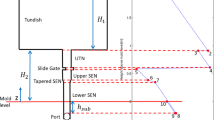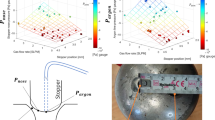Abstract
A new simple model of pressure and flow in the liquid-metal delivery system of continuous casting operations with stopper-rod flow control, PFSR, is introduced. This one-dimensional model calculates the gauge pressure distribution and flow rate in the complete tundish, stopper-rod, and nozzle system by solving a set of pressure-energy balance Bernoulli-type equations. It includes the effects of argon gas injection and its expansion according to the local pressure. PFSR is a MATLAB-based software package with a user-friendly graphical user interface (GUI). It employs an inverse model to solve the system of governing equations for any unknown chosen by the user. This enables fast and efficient parametric studies to investigate the effects of casting conditions and nozzle geometry under realistic conditions. The model is verified with three-dimensional computational fluid dynamics (CFD) simulations and validated with both water model and plant measurements. To overcome unrealistically low minimum pressure predictions in steel casters, two other physical phenomena should be considered: cavitation and non-primed annular/slug (waterfall-type) flow with large gas pockets. Preliminary results that include these two new phenomena into the PFSR model show that cavitation and air pockets (non-primed flow) can explain steel plant measurements and likely occur for most casting conditions in real casters with stopper-rod control systems.


















Similar content being viewed by others
Change history
31 October 2023
A Correction to this paper has been published: https://doi.org/10.1007/s11663-023-02929-8
References
H. Bai and B.G. Thomas: Metall. Mater. Trans. B, 2001, vol. 32(4), pp. 707–22.
H. Yang, H. Olia, and B. G. Thomas: Metals, 2021, vol. 11 (1), #116, pp. 1–28.
L. Zhang, Y. Wang, and X. Zuo: Metall. Mater. Trans. B, 2008, vol. 39(4), pp. 534–50.
U. Sjostrom, M. Burty, A. Gaggioli, and JP. Rador: in Proc. Steelmaking Conf., Iron and Steel Society of AIME, 1998, vol. 81, pp. 63–71.
M. Javurek, M. Thumfart, and R. Wincor: Steel Research Internat., 2010, vol. 81, pp. 668–74.
M. Thumfart and M. Javurek: Steel Research Internat., 2015, vol. 80(1), pp. 25–32.
K. G. Rackers and B. G. Thomas: in Proc. 78th Steelmaking Conf., Iron and Steel Society of AIME, Warrendale, PA, 1995, vol. 78, pp. 723-34.
S. Dawson: in Proc. 78th Steelmaking Conf., Iron and Steel Society of AIME, Warrendale, PA, 1990, vol. 73, pp.15-31.
I.V. Samarasekera, D.L. Anderson, and J.K. Brimacombe: Metall. Mater. Trans. B, 1982, vol. 13B(3), pp. 91–104.
S. Mahmood: MSc, University of Illinois at Urbana-Champaign, Urbana-Champaign, IL, Thesis, 2006.
M.L. Zappulla: PhD Thesis, Colorado School of Mines, Golden, CO, 2020.
H. Olia, H. Yang, S.-M. Cho, M. Liang, L. Das, and B.G. Thomas: Metall. Mater. Trans. B, 2022, vol. 53(3), pp. 1661–80.
K.G. Rackers: MSc, University of Illinois at Urbana-Champaign, Urbana-Champaign, IL, Thesis, 1995.
S.R. Cameron: in Proc. 75th Steelmaking Conf., Iron and Steel Society of AIME, Warrendale, PA, 1992, vol. 75, pp. 327–32.
N. Sidmar, F. Haers, R. Bauwens, R. Croock, and M. Moor: in Proc. 4th Int. Conf. on Continuous Casting, Preprints, Verlag Stahleisen mbH, Düsseldorf, 1988, vol. 2, pp. 503-14.
A. Jaffuel and J. P. Robyns: Continuous Casting of Steel, Biarritz, France, May, 1976.
E. S. Szekeres: in Proc. 4th Int. Conf. on Clean Steel, Balatonszeplak, Hungary, 1992.
United States Steel: Secondary Steelmaking or Ladle Metallurgy in The Making, Shaping, and Treating of Steel, Pittsburgh, PA, 1985, pp. 671–90.
B. Bergmann, N. Bannenberg, and R. Piepenbrock: in Proc. 1st European Conf. on Continuous Casting, Florence, Italy, Sept. 23-25, 1991, vol.1, pp. 1.501–08.
H.H. Bauer: Continuous Casting of Steel, Biarritz, France, May, 1976.
J.R. Bourguignon, J.M.Dixmier, and J.M. Henry: Steel Times, 1986, vol. 214 (6), p.312.
D. Bolger: in Proc. 77th Steelmaking Conf., Iron and Steel Society of AIME, Warrendale, PA, 1994, vol. 77, pp. 531-537.
Z. Chen, H. Olia, B. Petrus, M. Rembold, J. Bentsman, and B. G. Thomas: The Minerals, Metals & Materials Society (TMS), Warrendale, PA, 2019, pp. 23-35.
S. Ogibayashi: in Proc. 75th Steelmaking Conf., Toronto, Canada, Iron and Steel Society of AIME, Warrendale, PA, 1992, vol. 75, pp. 337-344.
E. Marino: Refractories for the Steel Industry, R. Amavis, eds., Elsevier Applied Science, New York, 1990, pp. 59-68.
P.M. Benson, Q.K. Robinson, and H.K. Park: in Proc. 76th ISS Ironmaking and Steelmaking Conf., Iron and Steel Society of AIME, Warrendale, PA, 1993, vol. 76, pp. 533-539.
E. Lührsen: In Proc. 1st European Conf. on Continuous Casting, Florence, Italy, Sept. 23-25, 1991, vol. 1, pp. 1.37-1.57.
N.A. McPherson and A. McLean: in "Continuous Casting - Tundish to Mold Transfer Operations,". Iron and Steel Society, Warrendale, PA, 1992, vol. 6, pp. 11–15.
E. Höffken, H. Lax, and G. Pietzko: in Proc. 4th Internat. Conf. on Continuous Casting,: Verlag Stahleisen mbH. Düsseldorf, 1988, vol. 2, pp. 461–73.
R. Liu, J. Sengupta, D. Crosbie, M.M. Yavuz, and B.G. Thomas: in AISTech Annual Meeting, vol. I, AIST, Warrendale, PA, 2011, pp. 1619-1631.
S.-M. Cho and B.G. Thomas: in AISTech Annual Meeting, AIST, Warrendale, PA, 2019, pp. 1317-1330.
K.A. Gürsoy: MSc, Middle East Technical University, Turkey, Thesis, 2014.
R. Liu, B.G. Thomas, J. Sengupta, S. D. CHUNG, and M. Trinh: ISIJ Internat., 2014, vol. 54 (10), pp. 2314–23.
R. Chudhary, G.-G. Lee, B.G. Thomas, S.-M. Cho, S.-H. Kim, and O.-D. Kwon: Metall. Mater. Trans. B, 2011, vol. 42B(4), pp. 300–15.
P. Ni, L.T.I. Jonsson, M. Ersson, and P.G. Jönsson: ISIJ Internat., 2017, vol. 57(12), pp. 2175–84.
R. Chudhary, G.-G. Lee, B.G. Thomas, and S.-H. Kim: Metall. Mater. Trans. B, 2008, vol. 39(12), pp. 870–74.
J. Eck: MSc, Luleå University of Technology, Sweden, Thesis, 2019, pp. 43–44.
R. Wang, H. Li, F. Guerra, C. Cathcart, and K. Chattopadhyay: in AISTech Annual Meeting. AIST, Warrendale, PA, 2021, vol. 190, pp. 1892–1901.
Fsolve: (Matlab subroutine from MathWorks Web Resource), https://www.mathworks.com/help/optim/ug/fsolve.html?s_tid=srchtitle_Fsolve_1, (accessed 5 April 2023).
E.W. Weisstein: Conical Frustum, (from MathWorld--A Wolfram Web Resource), https://mathworld.wolfram.com/ConicalFrustum.html, (accessed 5 April 2023).
F.M. White: Fluid Mechanics, 7th ed. McGraw Hill, New York, 2011, pp. 356–94.
H. Oertel, ed.: Prandtl-Essentials of Fluid Mechanics, 2nd ed., Springer, New York, NY, 2004, pp. 164-165.
B. Massey and J. Ward-Smith: Mechanics of Fluids, 8th ed. Taylor & Francis, New York, 2006, pp. 256–57.
ANSYS FLUENT 18.1-Theory Guide, ANSYS. Inc., Canonsburg, PA, 2017.
R. Liu, B. Forman, H. Yin, and Y. Lee: in AISTech Annual Meeting, AIST, Warrendale, PA, 2018, vol. 2, pp. 1793–1802..
C.E. Brennen: Cavitation and Bubble Dynamics, 1st ed. Oxford University Press, New York, 1995, pp. 15–20.
C.K. Gupta: Chemical Metallurgy: Principles and Practice, WILEY-VCH Verlag GmbH & Co. KGaA, Weinheim, 2003, pp. 273–75.
K.J. Laidler: Chemical Kinetics, Noida, Pearson, 2014, pp. 80–85.
M.J. Moran and H.N. Shapiro: Fundamentals of Engineering Thermodynamics, Wiley, Southern Gate, 2006, pp. 95–100.
B. Deo and R. Boom: Fundamentals of Steelmaking Metallurgy, Prentice Hall, New York, N.Y., 1993, p. 52.
E. T. Turkdogan: Fundamentals of Steelmaking, Institute of Materials, Leeds, UK, 1996, pp.96-97.
F. Oeters: Metallurgy of Steelmaking, Dusseldorf, Verlag Stahleise, 1994, p. 17.
J.-H. Wei and N.-W. Yu: Steel Res., 2002, vol. 73(4), pp. 135–42.
L. Zhang, S. Yang, K. Cai, J. Li, X. Wan, and B.G. Thomas: Metall Mater. Trans. B, 2007, vol. 38B(3), pp. 63–83.
M. Burty, C. Pussé, M. Alvarez, P. Gaujé, and G. Grehan: In Proc. 84th Steelmaking Conf., Iron and Steel Society, Warrendale, PA, 2001, vol. 84, pp. 89-98.
B. Mintz: ISIJ Int., 1999, vol. 39(9), pp. 833–55.
R. Liu and B.G. Thomas: Metall Mater. Trans. B, 2015, vol. 46B(2), pp. 388–405.
Acknowledgments
The authors thank Cleveland Cliffs, Tata Steel and Colorado School of Mines for their assistance in collecting and providing plant data, specifically Dylan Palmer and Edward Mather, Colorado School of Mines, and Dr. Rui Liu, ArcelorMittal, for their help with the plant measurements. The authors also sincerely thank Mingyi Liang, Colorado School of Mines, for his contributions of the CFD simulations and experimental data for the water model with System 1 while on internship at the research center for Plant 1. Support from the Continuous Casting Center at Colorado School of Mines, and the National Science Foundation GOALI grant (Grant No. CMMI 18-08731) are gratefully acknowledged. Provision of FLUENT licenses through the ANSYS Inc. academic partnership program is also much appreciated. The authors specially thank Alexandre Dolabella Resende, RHI Magnesita, and Dr. Seong-Mook Cho, Pukyong National University, for their kind comments and helpful feedback on PFSR.
Conflict of Interest
On behalf of all authors, the corresponding author states that there is no conflict of interest.
Author information
Authors and Affiliations
Corresponding author
Additional information
Publisher's Note
Springer Nature remains neutral with regard to jurisdictional claims in published maps and institutional affiliations.
Appendix: gap area calculation
Appendix: gap area calculation
The minimum cross-sectional area of the gap formed between the stopper-rod and tundish floor region, \({A}_{gap}\), [m2] controls the flow rate and pressure in the system. It is calculated based on 6 input parameters shown in Figure A1.
These include stopper-rod nose (tip) radius, \({r}_{tip}\), stopper-rod bend 1 radius, \({r}_{b1}\), stopper-rod bend 2 radius, \({r}_{b2}\), stopper-rod height from tip to the straight section, \({H}_{stopper}\), stopper-rod diameter, \({D}_{stopper}\), all in [mm] are input by the user to PFSR to define the stopper shape. To fully define the stopper geometry, 8 more parameters are required: the coordinates of the two tangent points between part-circles \({p}_{1}\) and \({p}_{2}\) , and their centers (\({x}_{c1}\),\({y}_{c1}\)) and (\({x}_{c2}\),\({y}_{c2}\)). This geometry is defined relative to the nose (tip) radius center at the origin, (0,0). The following 8 independent equations are solved simultaneously for these 8 unknowns:
where \({x}_{ci}\) and \({y}_{ci}\) (i = 1,2) are the \(x\)-coordinate and \(x\) y-coordinate of the bend \(i\).
The next step is to define the tundish floor geometry. The user must input: tundish floor radius, \({r}_{t}\), and diameter of the UTN entry, \({D}_{UTNa}\), both in [mm]. Assuming a single radius of curvature of this floor, this requires the coordinates of the circular segment (\({x}_{t}\),\({y}_{t}\)) with given radius \({r}_{t}\) and the coordinates of the tangent point (\({x}_{m}\),\({y}_{m}\)) where the stopper touches the tundish floor when the system is fully closed (i.e., no flow), as shown in Figure A2(a). These 4 parameters are found by solving the following 4 equations simultaneously:
From these parameters, the gap opening distance, \(S\), for any stopper-rod opening, \({h}_{sro}\), is calculated according to the geometry shown in Figure A2(b) as follows:
and the angle \(\theta \) , shown in Figure A2(b) is found from
where the horizontal and vertical distances between the center of the circular segment of the tundish floor and the center of the first bend, \({x}_{0}\) and \({y}_{0}\), are defined as follows:
Finally, the area of the gap, which is the lateral surface area of the conical frustum shown in Figure A3, is calculated as follows:[40]
where
Rights and permissions
Springer Nature or its licensor (e.g. a society or other partner) holds exclusive rights to this article under a publishing agreement with the author(s) or other rightsholder(s); author self-archiving of the accepted manuscript version of this article is solely governed by the terms of such publishing agreement and applicable law.
About this article
Cite this article
Olia, H., van der Plas, D. & Thomas, B.G. Pressure Distribution and Flow Rate Behavior in Continuous-Casting Stopper-Rod Systems: PFSR. Metall Mater Trans B 54, 2985–3009 (2023). https://doi.org/10.1007/s11663-023-02883-5
Received:
Accepted:
Published:
Issue Date:
DOI: https://doi.org/10.1007/s11663-023-02883-5







